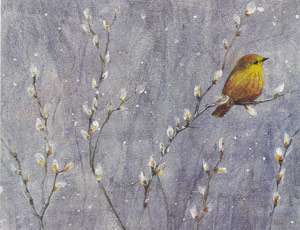
Last fall, I went to a nearby wetland with a pair of clippers and cut twigs from one willow shrub after another. It wasn’t hard to tell the willows from the non-willows because willows are the only woody plants in this area whose buds are covered by a single bud scale. These cute, pointy caps are very different from the overlapping scales that protect most buds through the winter. And the few woody plants with no protective scales are easily recognizable: their naked, embryonic leaves rely on a coating of woolliness to keep them from desiccating or freezing.
But telling one willow from another is quite a different matter. In my small collection, I had yellow buds, both small and large, as well as brownish and reddish buds that were small, medium, and large. A single specimen that I knew from past experience to be a pussy willow had some buds as small as the smallest and others more than twice as large. Some willows still had leaves last November, and some of those had stipules, while some didn’t; some were wavy-margined, and the edges of others had teeth.
I have been told that telling one willow from another is not as hopeless as I think it is, but because so many species – especially pussy willow – are variable in appearance and, in addition, because many of the willows hybridize, I am content to let most of them proliferate and diversify without my oversight. Even Thoreau was stopped by the willows, saying, “The more I study willows, the more I am confused.”
For a few weeks in early spring, pussy willows, however, are unmistakable, and though the name may seem fanciful, it is right on the mark: after the bud scales have split open, and before the leaves emerge, the catkins of the male flowers really do look like little blobs of glistening, gray kitten fur. Often there is still snow on the ground when pussy willow catkins begin to enlarge, and they shine like silver against a white background. Other willows have furry catkins, too, but unlike pussy willows, they will be disappointing if you bring them in the house in February and put them in water.
The opening buds of female pussy willows are not nearly as furry as those on male plants, and male and female willow flowers are always borne on separate plants. Those who like to bring twigs indoors in mid-winter to force flowers and leaves from their buds and get a jump on spring will do well to search out a big, male pussy willow in April and keep it in mind for the following February.
“Big” is a relative term, as pussy willows usually grow only to about 20 feet. In true shrub fashion, they have many clustered stems. New plants can arise from seeds, roots, or from branch fragments that break off. Cuttings grow roots very easily, and “willow water” – water in which willow stems have rooted – was used to induce rooting of twigs of other species before rooting hormones became available commercially.
After the kitten-fur phase, the minute flowers of pussy willow bloom and produce abundant pollen and nectar very early in the spring, when other plants have nothing at all to offer. A warm day will bring bees of all sizes and types and dozens of other insects to this first banquet. The catkins seem alive as they are jiggled by eager foragers.
The tiny seeds ripen early, too, and each has silky fluff allowing it to be wafted quite a distance by the wind. The seeds are not long-lived, and they can germinate within a day. Seeds lucky enough to land on moist soil in good sunlight can grow to several feet in height in their first year. Pussy willow’s tolerance of wetness and its vigorous growth make this species very useful in controlling erosion; plus, cut twigs root quickly and require no special care.
Pussy willow thickets are popular with many bird species. Alder and willow
flycatchers, gray catbirds, yellow warblers, and goldfinches commonly nest there, and many waterfowl and marsh birds also use willow for cover. Both deer and moose find the twigs palatable, and hare and porcupines eat both bark and buds. Grouse and squirrels eat just the buds.
Although pussy willows naturally germinate in wetlands, they will thrive if transplanted to drier soils. If some of their wildlife companions followed them into the backyard, they might be worth keeping an eye on at all times of the year, not just for the couple of weeks in spring when they are earning their name.


Discussion *